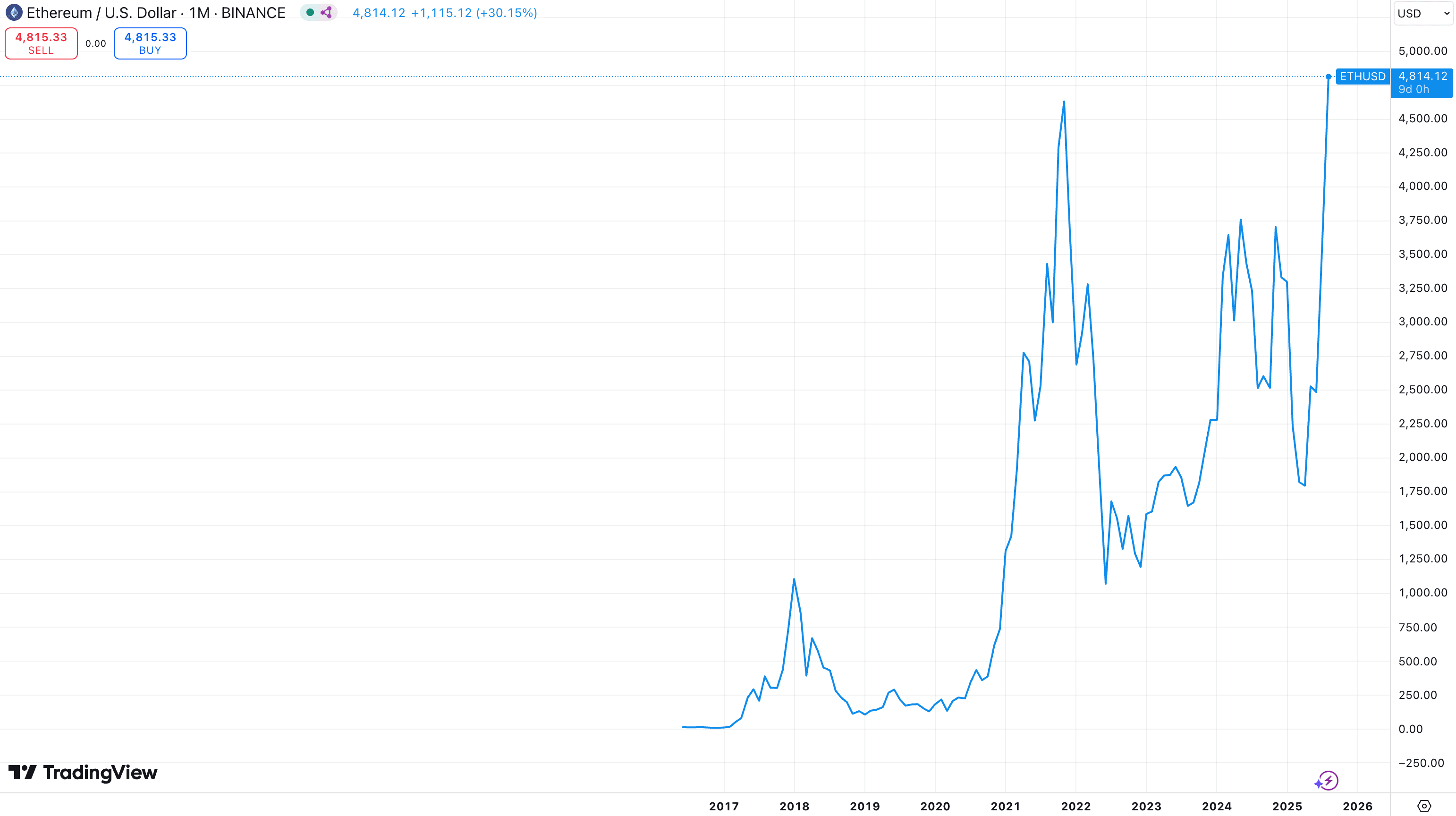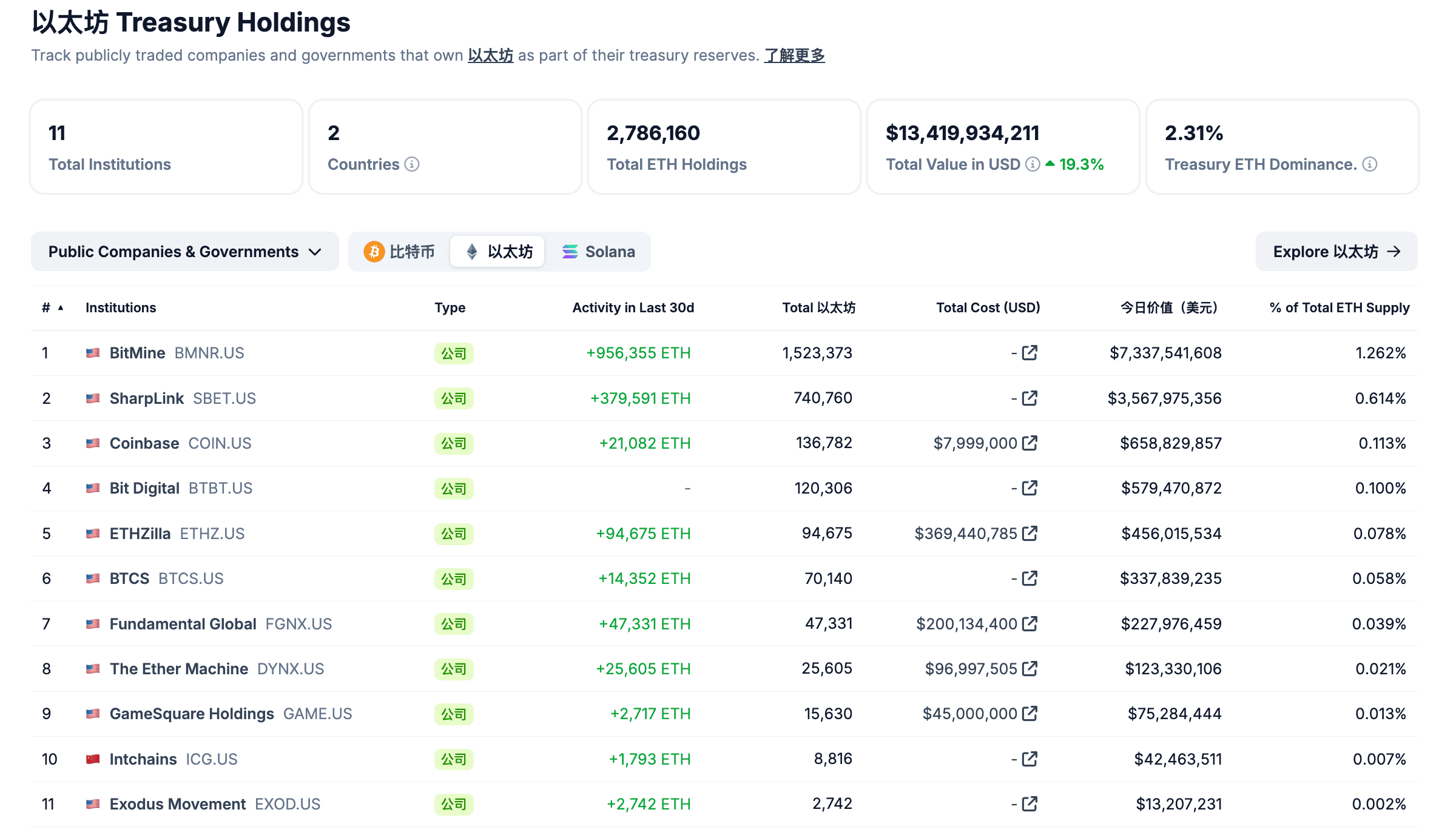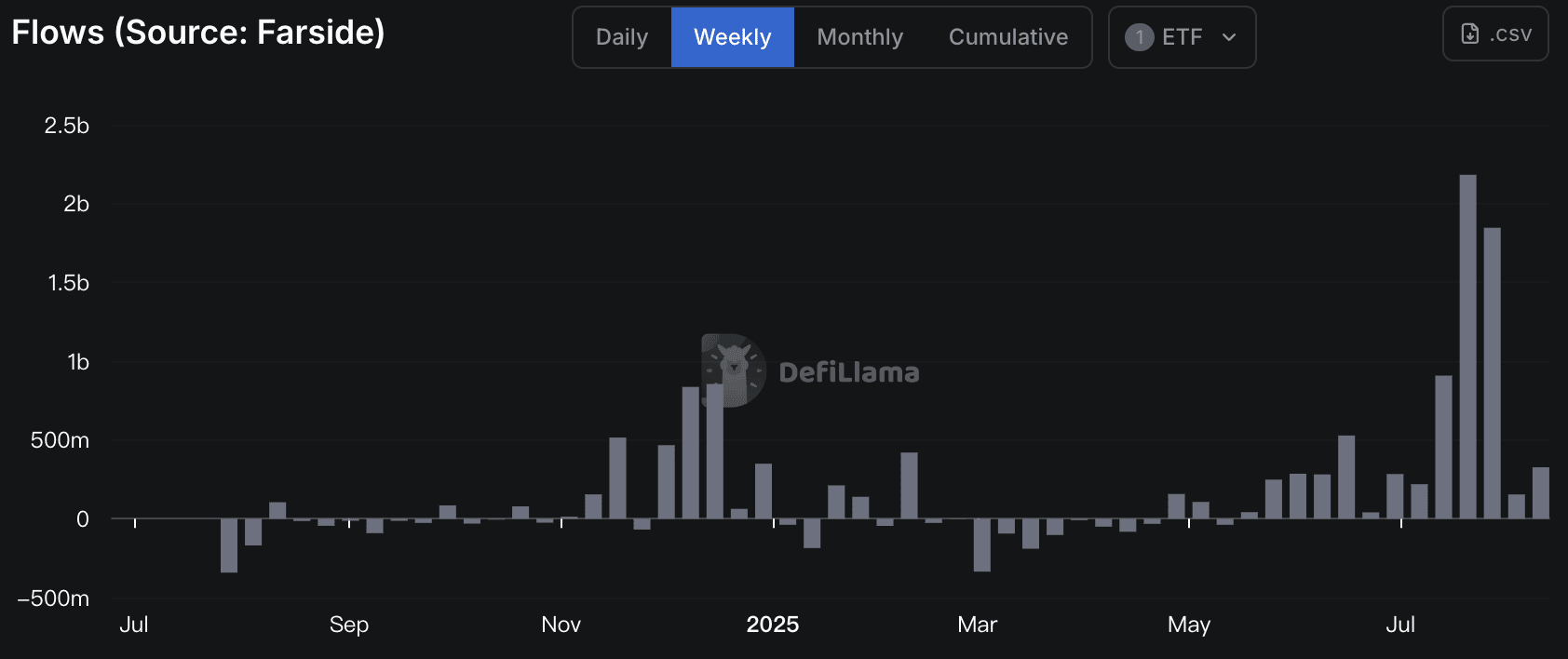After 1384 days, Ethereum has finally reached a new price high in this cycle.
On August 23, after a significant 'dovish' speech by Fed Chair Powell the night before, expectations for a September rate cut surged, with dollar assets rising across the board. A few hours later, Ethereum surged 14% to reach $4,887, setting a new historic high since its inception 11 years ago, with a market cap exceeding $586 billion, ranking 25th in total market capitalization among global tech companies, above well-known firms like Mastercard and Netflix.

ETH historical price chart; Source: TradingView
If Bitcoin completed its leap from a retail asset to an institutional asset in the last cycle, then Ethereum's breakthrough to new highs at this time may mark its entry into its 'sovereign narrative moment.' Wall Street's Ethereum 'call master' Tom Lee compared this strategic layout to a 'sovereign call option'—when Ethereum is widely adopted in global finance and AI infrastructure, companies holding significant stakes will be in a unique position.
Sean McNulty, head of derivatives trading for Asia Pacific at digital asset brokerage FalconX Ltd, stated that funds are flowing from Bitcoin to Ethereum, constituting a 'huge positive sentiment shift driven by strong spot ETF inflows, growing corporate financial adoption, and broader stablecoin tailwinds.'
This sentence also summarizes why Ethereum is reaching new highs at this time. Its delay is not absence, but rather waiting—waiting for sentiment and funds, policy and technology to converge at the same time. Now, this moment has finally arrived. For Ethereum, this is not just a price breakthrough, but a narrative shift.
Expectations for interest rate cuts have strengthened.
The shift in the macro environment has become the key driving force behind Ethereum's breakthrough to new highs. As the U.S. job market continues to weaken and core inflation gradually recedes, the market's bets on the Federal Reserve cutting interest rates within the year have significantly heated up.
Behind this trend are the signals released by Federal Reserve officials in recent intensive statements. Powell rarely acknowledged at the Jackson Hole central banking annual meeting that 'the risk balance is shifting'—inflation risks still exist, but the pressures of worsening employment are rising quickly. Under such dual pressures, the focus of monetary policy is starting to shift from 'maintaining high interest rates' to 'moderate easing.'
The market responded quickly to this, with CME's 'FedWatch' tool indicating that the probability of a 25 basis point rate cut in September is close to 90%. For risk assets, this not only means lower funding costs and improved liquidity but also represents the emergence of a policy turning point. Coupled with institutional buying and Ethereum's own narrative shift, this round of new highs for ETH is seen by many traders as a cyclical turning point, rather than just a technical breakout.
Public companies are buying, buying, buying!
If there are any changes in Ethereum's fundamentals during this round, the biggest difference is that it has gained entry from U.S. companies similar to Bitcoin's MicroStrategy.
On May 27, 2025, Nasdaq-listed company SharpLink Gaming announced a major strategic initiative, achieving a $425 million financing agreement through private equity investments (PIPE), planning to use the net proceeds to purchase Ethereum and make ETH the company's primary reserve asset. Notably, the leading investor in this transaction was Ethereum infrastructure development company Consensys Software Inc.
Related reading: (Ethereum's 'Strategy Moment'? SharpLink Gaming's $425 million bet on ETH reserves.)
It is also since then that corporations and small listed companies have increased their Ethereum allocations, with more and more Ethereum treasury companies becoming pioneers in this rising trend. As of August 2025, according to CoinGecko data, there are currently 17 companies/institutions holding 1,749,490 ETH, valued at approximately $7.5 billion. Meanwhile, Bitmine acquired 833,000 ETH within a month, accounting for nearly 1% of the global total supply, directly establishing its position as the 'world's largest publicly listed ETH treasury company.'
The logic behind this is that holding ETH not only allows for potential appreciation but also provides over 3% native yield through PoS staking, creating a long-term sustainable financial return. This is different from Bitcoin's treasury strategy, which is purely a price bet, and is closer to the operation of infrastructure-type assets, combining capital appreciation with cash flow. On August 10, Ethereum co-founder and Consensys CEO Joe Lubin stated, 'Treasury companies may push ETH's market value to surpass BTC within a year.'

Geoffrey Kendrick, global head of digital assets research at Standard Chartered Bank, stated that Ethereum treasury companies are now 'very worthwhile investments,' making them more attractive to investors than U.S. spot Ethereum ETFs. The net asset value (NAV) multiple of Ethereum treasury companies—i.e., market value divided by the value of held ETH—has now 'started to normalize' and is expected to remain above 1, making it a superior investment target compared to U.S. spot ETH ETFs.
Kendrick noted that since June, Ethereum fund management companies have purchased 1.6% of all circulating ETH, matching the purchase pace of ETH ETFs during the same period. By August 15, according to strategicethreserve data, the total amount of ETH held by Ethereum treasury companies and ETFs exceeded 10 million, accounting for approximately 8.3% of the current total supply.
Ethereum ETF inflows exceed Bitcoin.
Ethereum spot ETFs have finally welcomed their net inflow peak after a year. According to Farside data, over $2 billion has accumulated since July 4, quietly attracting $8.7 billion in funds during the first complete operational year, with AUM reaching $15.6 billion, creating a stable buying wall for the market.

A more important recent signal is that the number of ETH bought by ETFs has surpassed that of Bitcoin.
On August 8, the total fund inflow for ETH ETFs was $461 million, while BTC was only $404 million. BlackRock bought $250 million ETH, Fidelity bought $130 million ETH, and Grayscale bought $60 million ETH.
Unprecedented policy benefits.
On the narrative level, Ethereum's policy tailwind is not just a verbal commitment, but is gradually transforming into institutional support.
The most direct change comes from the gradually clarifying compliance path for ETH staking—regulatory agencies in some U.S. states have begun to recognize the accounting treatment of staking income under a licensed framework, meaning that institutions can disclose staking-related income more transparently in their financial reports.
At the same time, the successful advancement of a series of stablecoin bills also provides growth expectations for large stablecoins issued based on ETH (such as USDC, USDT), with core terms requiring reserve transparency, on-chain verifiability, and inter-state payment interoperability, which will directly strengthen Ethereum's central position in the issuance and settlement network of stablecoins.
More strategically significant is that the 'Project Crypto' plan, jointly led by the SEC and the Treasury Department, is adjusting the regulatory framework from a defensive stance to encouraging DeFi and blockchain financial product innovation. Under this policy tilt, Ethereum naturally becomes the primary recipient of benefits due to its absolute advantages in DeFi TVL (approximately 59.5% of the total) and stablecoin trading volume (about 50%).
The moderate shift in policy not only reduces institutional investors' concerns but also opens the door for long-term funds such as pensions and insurance funds to enter.
On August 7, 2025, a move destined to leave a significant mark in American financial history quietly took place. Trump signed an executive order allowing U.S. retirement savings accounts 401(k) to formally invest in 'alternative assets' including cryptocurrencies, private equity, and real estate. From then on, an asset class once excluded by the mainstream financial system was officially written into the nearly $90 trillion U.S. pension plan.
Related reading: (20 days, 4 statements, 3 bills, 2 executive orders, which crypto fields are benefitting from U.S. policy?)



